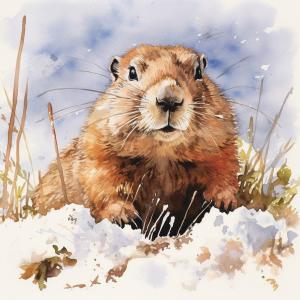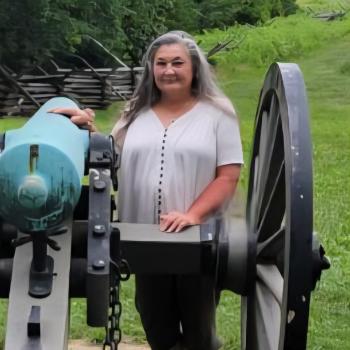
This is from last year, but I decided to resurrect it in honor of the day:
The Many Faces of February 2
February 2 is about to arrive. Most people around here (less than 150 miles from Punxsutawney, Pennsylvania), are anticipating the ruling of the prophetic rodent, Punxsutawney Phil and hoping for an early spring. Some may look for the same forecast from the legendary Wojak, rising from his winter sleep. In a third narrative, many around the world contemplate the blessing of candles, the purification of Mary, and Jesus’ first visit with his parents to the temple.
The Sacred Groundhog
According to Stormfax, “in 1723, the Delaware Indians settled Punxsutawney, Pennsylvania as a campsite halfway between the Allegheny and the Susquehanna Rivers. The town is 90 miles northeast of Pittsburgh, at the intersection of Route 36 and Route 119. The Delawares considered groundhogs honorable ancestors. According to the original creation beliefs of the Delaware Indians, their forebears began life as animals in ‘Mother Earth’ and emerged centuries later to hunt and live as men. The name Punxsutawney comes from the Indian name for the location ponksad-uteney which means the town of the sandflies. The name woodchuck comes from the Native American legend of ‘Wojak, the groundhog,’ considered by them to be their ancestral grandfather.”
The Candles
German settlers arrived at approximately that same time bringing from Europe the tradition known as Candlemas Day, which originated with the pagan celebration of Imbolc. The belief was rooted in the weather conditions at the midpoint between the Winter Solstice and the Spring Equinox. If the weather was fair on that day, the second half of winter would be stormy and cold, but if the weather was stern and cold on that day, the second half of winter would be fair.
For early Christians in Europe, Candlemas Day was the day for clergy to bless candles and distribute them to the people, bringing light to the dark of winter, and symbolically, bringing spiritual light out of darkness. Lighted candles were placed in the windows of Christian homes. The date for Candlemas was February 2.
The Light and the Light
Two biblical points of reference appear supporting the February 2 date of Candlemas which is also referred to as Presentation (of Christ) at the Temple, or Hypapante, and the purification rite of Mary.
According to Luke 2:22-39:
“When the time came for the purification rites required by the Law of Moses, Joseph and Mary took [Jesus] to Jerusalem to present him to the Lord (as it is written in the Law of the Lord, ‘Every firstborn male is to be consecrated to the Lord’), and to offer a sacrifice in keeping with what is said in the Law of the Lord: a pair of doves or two young pigeons.
“Now there was a man in Jerusalem called Simeon, who was righteous and devout. He was waiting for the consolation of Israel, and the Holy Spirit was on him. It had been revealed to him by the Holy Spirit that he would not die before he had seen the Lord’s Messiah. Moved by the Spirit, he went into the temple courts. When the parents brought in the child Jesus to do for him what the custom of the Law required, Simeon took him in his arms and praised God, saying: ‘Sovereign Lord, as you have promised,
you may now dismiss your servant in peace. For my eyes have seen your salvation, which you have prepared in the sight of all nations: a light for revelation to the Gentiles, and the glory of your people Israel.’
“The child’s father and mother marveled at what was said about him. Then Simeon blessed them and said to Mary, his mother: ‘This child is destined to cause the falling and rising of many in Israel, and to be a sign that will be spoken against, so that the thoughts of many hearts will be revealed. And a sword will pierce your own soul too.’
“There was also a prophet, Anna, the daughter of Penuel, of the tribe of Asher. She was very old; she had lived with her husband seven years after her marriage, and then was a widow until she was eighty-four. She never left the temple but worshiped night and day, fasting and praying. Coming up to them at that very moment, she gave thanks to God and spoke about the child to all who were looking forward to the redemption of Jerusalem.
When Joseph and Mary had done everything required by the Law of the Lord, they returned to Galilee to their own town of Nazareth.”
The date here is important because according to Leviticus 12, Mary would have waited 40 days to appear in the temple for her purification and sacrifice. Forty days from the traditional birth of Jesus on December 25 would be February 2.
Some World History
The earliest reference to a celebration of these events is from the late 4th century when the pilgrim Etheriae documented it in Peregrinatio Etheriae. The date he gave was February 14. It was Justinian I who moved the festival to February 2, (40 days after Christmas). By the 5th century, the custom of the lighted candles was added and the name Candlemas became the common reference. Pope Sergius I continued the custom in Rome. Today, the festival is primarily Catholic and associated with the Virgin Mary.
Some American History
So back to our American history “the earliest reference to Groundhog Day [as we know it] can be found at the Pennsylvania Dutch Folklore Center at Franklin and Marshall College:
“February 4, 1841 – from Morgantown, Berks County (Pennsylvania) storekeeper James Morris’ diary…’Last Tuesday, the 2nd, was Candlemas day, the day on which, according to the Germans, the Groundhog peeps out of his winter quarters and if he sees his shadow he pops back for another six weeks nap, but if the day be cloudy he remains out, as the weather is to be moderate.’
“Pennsylvania’s official celebration of Groundhog Day began on February 2nd, 1886 with a proclamation in The Punxsutawney Spirit by the newspaper’s editor, Clymer Freas: ‘Today is groundhog day and up to the time of going to press the beast has not seen its shadow.’ The groundhog was given the name ‘Punxsutawney Phil, Seer of Seers, Sage of Sages, Prognosticator of Prognosticators, and Weather Prophet Extraordinary’ and his hometown thus called the ‘Weather Capital of the World’” (Stormfax).
There you go! In honor of both occasions, here are some early rhymes from our cousins:
Old English:
If Candlemas be fair and bright,
Winter has another flight.
If Candlemas brings clouds and rain,
Winter will not come again.
In Scotland:
If Candlemas Day is bright and clear,
There’ll be two winters in the year.
From Germany:
For as the sun shines on Candlemas Day,
So far will the snow swirl until May.
For as the snow blows on Candlemas Day,
So far will the sun shine before May.
And in early America:
If the sun shines on Groundhog Day;
Half the fuel and half the hay.
In closing, 17th-century poet and priest Robert Herrick wrote:
Down with the rosemary and bays,
Down with the mistletoe ;
Instead of holly, now up-raise
The greener box (for show).
The holly hitherto did sway ;
Let box now domineer
Until the dancing Easter day,
Or Easter’s eve appear.
Then youthful box which now hath grace
Your houses to renew ;
Grown old, surrender must his place
Unto the crisped yew.
When yew is out, then birch comes in,
And many flowers beside ;
Both of a fresh and fragrant kin
To honour Whitsuntide.
Green rushes, then, and sweetest bents,
With cooler oaken boughs,
Come in for comely ornaments
To re-adorn the house.
Thus times do shift ; each thing his turn does hold ;
New things succeed, as former things grow old.
God bless you, and happy February 2, however you celebrate it!













